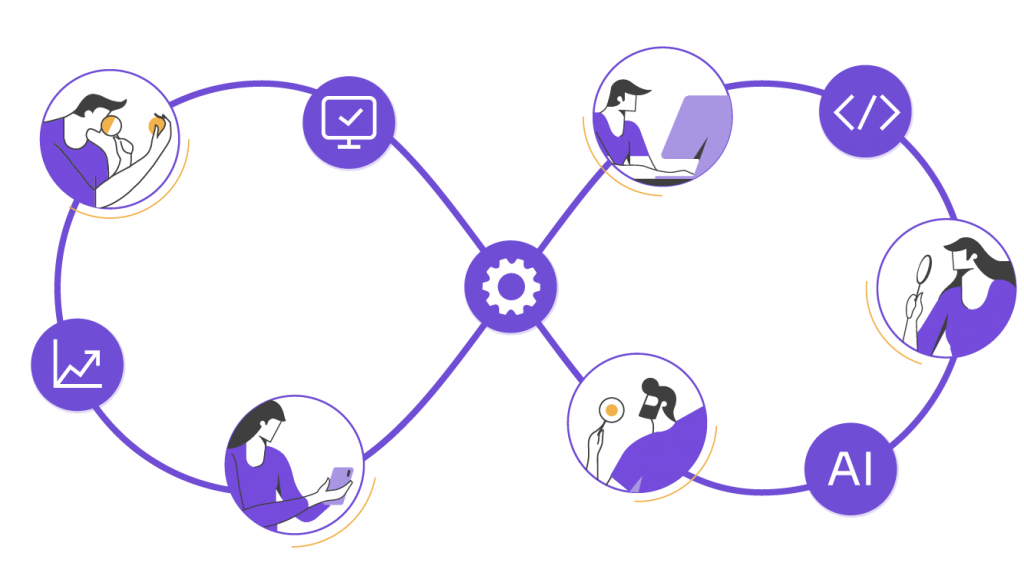If your system can’t handle failure, it’s already failing. Site Reliability Engineering (SRE) introduces a mindset that redefines how we approach scale, stability, and automation. Here’s why its principles matter — and how they’re reshaping modern software.


Site Reliability Engineering is more than a buzzword; it’s a philosophy that integrates aspects of software engineering and applies them to infrastructure and operations problems.
The main goal is to create scalable software systems and highly reliable platforms. But what does this entail, and how do SRE teams achieve these objectives?
Let’s explore together.
Need help harnessing SRE practices? Explore our DevOps services and let’s talk about how we can help you grow your business!
Understanding Site Reliability Engineering Principles
SRE principles are the foundation upon which the practice is built. They focus on automation, measurement, and gaining confidence in engineering principles.
By treating operations as if it’s a software problem, SRE teams aim to automate repetitive tasks, ideally spending less than 50% of their time on operational tasks. Not only does this approach improve efficiency but also allows engineers to focus on more strategic and measurable tasks.
SRE principles emphasize automating tasks to focus on strategic work. Effective SRE teams develop software tools that reduce human intervention in routine operations, enhancing efficiency and focusing on initiatives that drive business value.
They also stress setting clear service level objectives (SLOs) to guide system reliability. These objectives are quite straightforward to build when the organization has already defined agreements (SLAs). Otherwise, the first step is to start measuring and quantifying confidence in the systems they maintain to harness a continuous improvement culture of confidence.
These SLOs will guide SREs in maintaining the balance between launching features and streamlining system stability.
Adhering to these objectives helps SRE teams measure success in reliability initiatives and drive customer satisfaction. This helps teams to make informed decisions about where to allocate resources and focus on areas that will most impact service confidence and customer experience.
Moreover, embracing risk is an integral part of the SRE model. It acknowledges that while 100% reliability is an impractical goal, understanding and managing the trade-offs between new feature development and system stability is crucial.
This approach allows SRE teams to innovate confidently, knowing that they have a framework in place to assess and mitigate risks effectively.
The Role of Site Reliability Engineers


Enabling System Resilience
Site Reliability Engineers are the architects of resilience. They bridge the gap between development and operations teams. How? Operations site reliability engineers create automated tools for themselves and others to increase the system’s reliability and reduce manual work.
This way, they aim to ensure that software not only meets design and implementation standards but also can withstand real-world pressures.
Watch this webinar on How to Use Automation to Increase Test Coverage!
Managing Responsibilities and Different Tools
Site reliability engineers focus on a broad spectrum of responsibilities, from monitoring system performance to responding to incidents. Their role is crucial in maintaining reliability, as they implement automation tools and incident response protocols that minimize downtime and enable a seamless customer experience.
Using monitoring and incident response tools, they can identify potential issues early and react quickly to problems, safeguarding system reliability and maintaining overall system health.
Navigating Complex Systems
Furthermore, the development and operations teams rely on the expertise of site reliability engineers to navigate the complexities of large-scale systems. These engineers bring a unique perspective that combines software engineering with operational insights, enabling them to design systems that are not only functional but also resilient and scalable.
Their work aims to ensure that the operational load is balanced and that the development teams can focus on building features without compromising on system reliability.
Want to keep learning about monitoring? Get our Monitoring Modern Infrastructure E-book for free!
Building Effective SRE Teams


SRE teams are cross-functional, comprising individuals with diverse skills in software engineering, system administration, and sometimes even network engineering.
For them, building an effective SRE team lies in fostering a culture of continuous learning and improvement, encouraging experimentation, and embracing failure as a learning opportunity.
Key Principles for SRE Teams:
Collaboration
Encourage open communication between software engineers and the operations team to foster a shared understanding of goals and challenges.
Innovation
Promote a culture of innovation where new ideas are welcomed and tested, balancing the need for stability with the desire for new features.
Learning
Embrace failures as learning opportunities, analyze incidents to prevent future occurrences and continuously improve system reliability. This focus not only enhances efficiency but also allows the team to allocate more time to strategic initiatives that drive business value, keeping the primary focus on long-term reliability goals.
By automating deployment processes and incident response workflows, SRE teams can maintain high reliability and performance while supporting rapid feature development, seamlessly integrating into the existing software workflow.
The Importance of System Reliability


System reliability is the cornerstone of user satisfaction and business success. It’s not just about keeping the lights on; it’s about delivering a reliable service that is available, performant, and scalable.e.
This requires a deep understanding of both the systems and the underlying infrastructure, as well as a commitment to rigorous testing and quality assurance practices.
Why is System Reliability Crucial?
- Customer Satisfaction: A reliable system enables a seamless user experience, directly impacting customer satisfaction and loyalty.
- Business Continuity: High system reliability minimizes software downtime, checking whether business operations can continue without disruption.
- Competitive Advantage: In today’s digital landscape, system reliability can be a key differentiator, setting businesses apart from their competitors.
Maintaining system reliability in large-scale systems presents unique challenges, including managing the complexity of distributed architectures and ensuring the seamless integration of new features.
SSite reliability engineering teams employ a range of strategies, such as implementing service level agreements (SLAs) and service level indicators (SLIs), to monitor and uphold system reliability. These measures provide key metrics and actionable data that guide decision-making and help in preemptively addressing potential issues, thereby improving the overall reliability and service health of the system.
SRE and Continuous Improvement


Continuous improvement is at the heart of SRE. It involves regularly assessing and enhancing the reliability, performance, and efficiency of systems. This is achieved through a cycle of monitoring, incident response, post-mortem analysis, and implementing changes to prevent future issues.
How SRE Promotes Continuous Improvement:
- Monitoring and Alerting: Use advanced monitoring tools to track system performance and set up alerts for anomalies.
- Appropriate Incident Response: Develop robust incident response protocols to address issues swiftly and minimize impact on users.
- Post-Mortem Analysis: Conduct thorough analyses of incidents to identify root causes and implement corrective actions.
By focusing on continuous improvement, the software engineering team not only addresses existing problems but also anticipates and prevents future issues. This proactive approach is essential for maintaining high levels of customer satisfaction and boosting the long-term success of the business.
Another essential aspect of continuous improvement is documenting learning through post-incident analysis reports. These reports help teams identify root causes, share knowledge across departments, and build a culture of transparency that drives future resilience.
SRE Best Practices
- Automation: Automate repetitive tasks to reduce errors and free up time for more strategic work. Automating routine tasks is the answer to is the answer to scaling efficiently—without adding overhead or sacrificing quality.
- Monitoring and Alerting: Implement comprehensive observability and alerting to detect and respond to issues swiftly.
- Capacity Planning: Regularly assess system capacity and plan for future growth to boost scalability.
- Blameless Postmortems: Conduct postmortems without blame to learn from failures and improve system reliability.
Incorporating SRE best practices into the daily workflow is essential for maintaining high levels of system reliability and efficiency. These practices, such as establishing service level agreements (SLAs), focusing on eliminating toil, and implementing repeatable processes, are fundamental to the SRE process.
They allow the team to be aligned with the business’s goals and to meet the demands of both current and future users. By adhering to these best practices, SRE teams can effectively balance the need for new features with the necessity of system stability, thereby enhancing the overall customer experience.
Don’t miss this article! How to Make Testing Progress Visible
Challenges in Site Reliability Engineering


How do we tackle the ever-evolving challenges of maintaining system reliability? The key lies in staying ahead of technology trends, continuously improving our skills, and adapting our strategies to meet the demands of increasingly complex systems.
One of the primary challenges faced by teams is managing the balance between releasing new features and maintaining system stability.
This balance is crucial for ensuring customer satisfaction while also driving business growth. SRE teams address this challenge by employing error budgets, which provide a quantifiable measure of how much risk is acceptable when introducing new features.
Error budgets help teams make informed decisions about when to prioritize stability over new development so that the system remains reliable and efficient.
Strong management support is crucial for SRE initiatives. It fosters a culture valuing reliability and empowers teams to secure the resources and autonomy needed to implement effective practices. This is a key factor in the success of sre principles and efforts, enabling teams to innovate and enhance system reliability in ways that drive customer satisfaction and business success.
The Future of SRE


What does the future hold for Site Reliability Engineering? As technology advances, the role of SRE will become even more critical. We’ll see a greater emphasis on automation, machine learning for predictive analysis, and more sophisticated tools for managing system complexity.
The future of SRE is also likely to see an increased focus on integrating security practices into the reliability framework. As cyber threats become more sophisticated, ensuring the security of production environments will be an integral part of maintaining system reliability.
This integration of security and reliability practices will require SRE teams to develop new skills and collaborate closely with security experts to protect against threats while maintaining high levels of system performance and availability. They will also need to embed reliability principles into every layer of infrastructure.
Additionally, the adoption of cloud-native technologies and microservices architectures will continue to shape the SRE landscape. These technologies offer new opportunities for scaling and improving system reliability but also introduce complexity that must be managed effectively.
SRE teams will need to adapt their practices to these evolving architectures, leveraging the flexibility and scalability of the cloud while enabling reliability to remain a top priority.
As organizations scale their infrastructure, incorporating a strong governance service becomes essential. This helps standardize processes, enforce compliance, and align reliability goals with business objectives, especially in highly regulated industries.
Engaging with the SRE Community


How can we, as a community, share knowledge and best practices in SRE? Engaging in forums, attending conferences, and contributing to open-source projects are excellent ways to stay connected and learn from each other.
The SRE community is a vibrant and growing network of professionals who are passionate about improving system reliability and efficiency. By participating in community events and discussions, individuals can gain insights into the latest trends and challenges in the field, share their experiences, and learn from the successes and failures of others.
This collective knowledge is invaluable for advancing the practice of site reliability engineering and ensuring that it continues to evolve in response to the changing needs of businesses and their customers.
Real-World Examples of SRE Success
Let’s look at some tangible examples where SRE principles have been successfully applied:
- A major e-commerce platform implemented automated scaling solutions, reducing downtime by 75%.
- A financial services company used blameless postmortems to improve their incident response time by 50%.
These examples highlight the impact that effective site reliability engineering can have not only on a technology company but also on all industries. By focusing on automation, incident response, and continuous improvement, companies can significantly enhance their system reliability and efficiency.
These successes demonstrate the value of SRE practices in real-world settings, showing how they can lead to improved customer satisfaction and business outcomes.
In a Nutshell – Why SRE?


As we’ve explored, Site Reliability Engineering is not just about keeping systems running; it’s about ensuring they can evolve and grow in a sustainable way. It’s a journey of continuous improvement, learning, and adaptation.
By embracing the principles of SRE, we can build more reliable, efficient, and resilient software, ready to meet the challenges of tomorrow.
Through collaboration, innovation, and a commitment to excellence, we can boost our systems to meet the highest standards of reliability and performance, delivering exceptional value to our customers and driving the success of our businesses.
Let’s embark on this journey together, pushing the boundaries of what’s possible and shaping the future of software reliability.
FAQs – Site Reliability Engineering (SRE)


What Are The 7 Principles of SRE?
The seven principles of SRE include:
- Embracing Risk: Balancing the need for stability and innovation by managing acceptable levels of risk.
- Service Level Objectives (SLOs): Defining and using SLOs to measure and achieve desired reliability levels.
- Eliminating Toil: Automating repetitive, manual tasks to focus on work that adds value.
- Automation: Leveraging automation to handle tasks efficiently and reduce the chance of human error.
- Monitoring and Alerting: Implementing comprehensive monitoring and alerting systems to detect and address issues proactively.
- Blameless Postmortems: Learning from failures without assigning blame to continuously enhance reliability.
- Shared Ownership: Encouraging collaboration between teams to foster reliability and performance.
What Is The Primary Goal of SRE?
The primary goal of SRE is to create and maintain scalable and reliable software systems. This involves ensuring that systems meet defined service level objectives (SLOs), automating operations tasks to reduce toil, and continuously improving system performance and reliability. SRE aims to balance the need for rapid innovation with the necessity of system stability, providing users with high-quality services.
Why Need SRE?
SRE is needed to enable complex, large-scale systems to be reliable, efficient, and capable of meeting user expectations. In today’s digital landscape, downtime or poor performance can have significant business impacts, including lost revenue and damaged reputation. SRE helps businesses manage risk, automate operations, and improve service reliability, which is crucial for customer satisfaction and business success.
Why Do You Want to Learn and Practice SRE?
Becoming a site reliability engineer offers the opportunity to work at the intersection of development and operations, solving complex challenges to improve system reliability and efficiency. It’s a role that requires creativity, problem-solving skills, and a passion for continuous learning. SREs play a critical role in enabling services to meet user needs and business goals, making it a rewarding and impactful career choice.
What Is SRE in Finance?
In the financial industry, SRE supports the availability and performance of systems such as trading platforms, customer portals, and real-time transaction processing. These environments demand both operational expertise and the application of software engineering principles to maintain continuity under pressure.
How Does SRE Support Financial Systems?
By integrating into the software development lifecycle, SREs collaborate with system administrators and developers to promote resilience, reduce risk, and support regulatory demands. This model helps organizations build highly reliable software systems aligned with business and compliance needs.
How We Can Help You


With over 16 years of experience and a global presence, Abstracta is a leading technology solutions company with offices in the United States, Chile, Colombia, and Uruguay. We specialize in software development, AI-driven innovations & copilots, and end-to-end software testing services.
We believe that actively bonding ties propels us further and helps us enhance our clients’ software. That’s why we’ve forged robust partnerships with industry leaders like Microsoft, Datadog, Tricentis, Perforce BlazeMeter, and Saucelabs, to create and implement customized solutions for your business applications and empower companies with AI.
Would you like to explore how our DevOps services can revolutionize your projects? Reach out and join us in shaping your business future.


Follow us on Linkedin & X to be part of our community!
Recommended for You
AI for Dummies, a Powerful Guide for All
Uruguay: The Best Hub for Software QA Engineers in Latin America?
LLMOps and Product Lifecycle Management
Tags In
Fabian Baptista
Related Posts
Abstracta Identified as a Top Software Testing Firm by Clutch.co
Here at Abstracta, we apply highly sophisticated engineering and automation processes to our clients’ testing practices and software development lifecycle, focusing on increasing product quality and reducing time to market. Over the last few years, we have stayed ahead of software testing trends and technologies to best…
API Testing Guide: A Step-by-Step Approach for Robust APIs
Master API testing with this guide on functionality, security, and performance testing. Discover top tools and best practices to optimize your APIs.
Search
Contents
Categories
- Acceptance testing
- Accessibility Testing
- AI
- API Testing
- Development
- DevOps
- Fintech
- Functional Software Testing
- Healthtech
- Mobile Testing
- Observability Testing
- Partners
- Performance Testing
- Press
- Security Testing
- Software Quality
- Software Testing
- Test Automation
- Testing Strategy
- Testing Tools
- Work Culture







